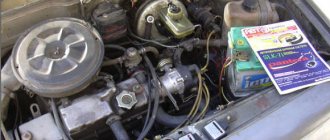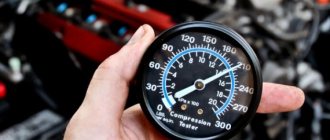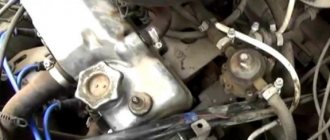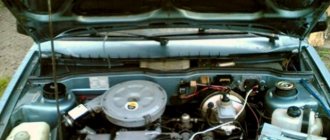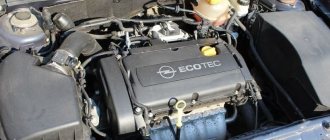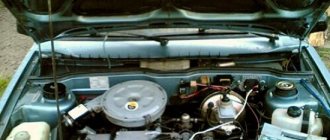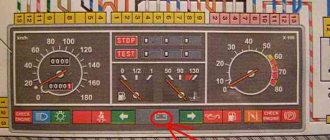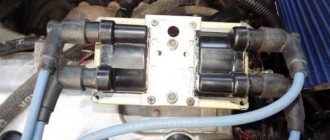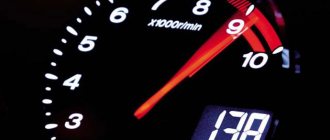Carburetor or injector
While the whole world has made a choice in favor of injection engines, in our country the intensity of the debate on the topic “injector or carburetor” does not subside. Mostly, the debate revolves around the possibility of field repair of an engine with a carburetor or an injector. Adherents of the first passionately prove that a failed carburetor engine can be easily repaired literally “in the open field.” And if the injection engine fails, prepare a tow rope and go to the service center.
Proponents of injectors raise the objection that injection engines break down much less often, and there are only two typical malfunctions.
- Damage to the crankshaft position sensor.
- Fuel pump failure.
At the same time, the “injection guys” rather sarcastically clarify that the fuel pump can just as easily break down on a carburetor engine, and the sensor costs a penny and can be easily changed even in the field. Perhaps we should admit that the supporters of injection are somewhat right. But if you happen to drive a carburetor version, then you shouldn’t chase the illusory savings of a glass of gasoline per 100 kilometers. You shouldn’t start switching to a new type of power system just because the VAZ 2109 carburetor failed when you pressed the gas pedal.
If something happens, the carburetor “nine”, even if it sneezes in blue puffs, even with a sinking accelerator pedal, will take you home - after all, it’s worth something.
Let's sum it up
So, we see that a car can jerk for many reasons. As a rule, it helps to alternately replace consumables (filters, spark plugs, armored wires) and clean the injector nozzles. It is better to entrust the check of electronics and sensors to a specialist at a service station.
Often the problem can also lie in the transmission; the car also “jumps” in this case - especially with an automatic transmission, although manual transmissions are also prone to failure. In a manual transmission, replace the basket and/or clutch disc.
The automatic transmission checks the oil for its level and quality. Please note that qualified repair of an automatic transmission “in a garage” is impossible; it must be diagnosed at a service station.
Ozone or Solex
With the start of production of the VAZ 2108 and 2109, AvtoVAZ designers abandoned the use of Ozone carburetors, in which many complex options had no practical meaning. What was the cost of the forced idle economizer alone, which supposedly served to save fuel during engine braking? Neither engine braking became widespread, nor did the EPKH bring any noticeable savings, but it provided drivers with quite a few headaches when pressing the gas.
When switching to “eights” and “nines”, the plant returned to a simpler version of the carburetor. It was distributed under the name Solex: after the name of the French company that produced its prototype. Solex lost the pneumatic drive for the secondary chamber damper, a semi-automatic starting device, and an autonomous idle system.
The design has been simplified and reliability has increased. It is Solex that, as a rule, owners of carburetor versions of the VAZ 2109 deal with.
Video - Why the engine speed fluctuates at idle
The occurrence of the above malfunctions is a consequence of violations of the operating conditions defined by the manufacturer, or the negative impact of external climatic factors: high humidity, abnormally high (low) temperature values or its sharp fluctuations.
In addition, it must be taken into account that the reason for the incorrect functioning of the “nine” carburetor may be a malfunction of the vehicle’s power system, ignition system, or a clogged air filter.
Depending on the type of VAZ engine, there are different types of reasons. Let's start with carburetor cars of Soviet and Russian production VAZ 2107 and VAZ 2109.
In a situation where the reason that the VAZ 21099 (carburetor) has variable speed is due to incorrect adjustment, the vast majority of car enthusiasts, especially those with little practical experience, prefer to use the services of professional auto mechanics. However, you can perform this operation yourself, using the instructions presented below. As an example, let's look at the technology for adjusting the idle speed of the Solex carburetor, which is the most common on the VAZ 2109 and VAZ 21099 models.
The objects of adjustment are the screws that regulate the “quantity” (Figure 1, position 1) and “quality” (Figure 1, position 2) of the combustible mixture, and the working tool is a screwdriver with a flat blade and an external tachometer, which makes it easy to take readings.
Picture 1
Non-carburetor causes of engine failure
Car owners usually refer to failures as unpredictable short-term interruptions in the operation of a car’s internal combustion engine. Failures belong to the category of so-called “unreasonable”, or, more precisely, multi-cause failures. It is impossible to say unequivocally about such breakdowns: failures appear - change the spark plugs. More precisely, it is possible to say, but it is not a fact that after replacement the failures will disappear. Although this also happens.
So failures in the operation of a carburetor engine are not necessarily related to the device itself. And before you start working on such a complex unit, you should exclude the influence of other reasons.
- Mechanical failure of the drive.
- Ignition system malfunctions.
- Failures of the power system located outside the carburetor.
These groups of negative factors stand out among others. Let's look at them in detail.
| Malfunctions | Your actions |
| Mechanical failures of the drive include, first of all, a faulty throttle cable. | It simply needs to be replaced. |
| In the ignition system, spark plugs most often fail. | Excessive carbon must be cleaned, faulty spark plugs must be replaced. |
| High-voltage wires fail a little less often. | It is not recommended to check the spark “to ground”; this is dangerous. You should measure the resistance of the wires using an ohmmeter and make sure that it corresponds to the nominal value. |
| Excessive wear of the carbon contact in the distributor cover. | Rule out this reason. |
| If everything is in order with the ignition system, and the engine still fails when you press the pedal sharply, move on to the power system. | Most often the fuel pump fails. Start with an inspection of this particular unit. |
Remove the outlet pipe from the fitting. Press the fuel pump manual drive lever vigorously. There should be an intense stream of fuel coming out of the hose. If not, the pump is faulty and must be repaired or replaced. Clean the fuel line filters from the tank to the carburetor, and blow out the pipelines themselves.
If everything is in order with the power and ignition systems, move on to the carburetor itself.
Let's sum it up
So, we see that a car can jerk for many reasons. As a rule, it helps to alternately replace consumables (filters, spark plugs, armored wires) and clean the injector nozzles. It is better to entrust the check of electronics and sensors to a specialist at a service station.
Often the problem can also lie in the transmission; the car also “jumps” in this case - especially with an automatic transmission, although manual transmissions are also prone to failure. In a manual transmission, replace the basket and/or clutch disc.
The automatic transmission checks the oil for its level and quality. Please note that qualified repair of an automatic transmission “in a garage” is impossible; it must be diagnosed at a service station.
VAZ 2109 carburetor malfunctions
The carburetor is one of the most delicate components of the VAZ 2109 car to configure. Its repair requires experience. The maximum that an amateur can handle is replacing the throttle cable of a VAZ 2109. Many subtle technologies interact with each other in the process of preparing the air-fuel mixture. By adjusting the operation in acceleration mode, you risk disrupting the idle speed adjustment, and vice versa. So you should start repairing the carburetor yourself with caution and without excessive self-confidence.
A significant volume of fuel with all impurities, chemical and mechanical inclusions, conceivable and inconceivable contaminants passes through the carburetor. This means that cleaning will never harm the carburetor. It is about total cleaning that we will talk about.
Everything is cleaned, including fuel injectors, air jets, transition channels, filter elements and metering wells. This is done like this:
- disconnect the mechanical throttle actuator;
- separate the inlet and outlet fuel pipes;
- wrap the freed carburetor with aluminum foil of sufficient width;
- place the wrapped carburetor in a plastic bucket to protect it from leaking;
- fill the carburetor with acetone or other strong solvent;
- leave the carburetor in a flooded state for a day.
Keep in mind that this should be done in a well-ventilated non-residential area. At the end of washing, drain the solvent, rinse the unit with a running stream of solvent, blow with a stream of compressed air, and dry. Install the carburetor in its original place. Try your "nine".
If a radical flush solves the problem, ride to your heart's content. If you haven’t decided, it’s time to turn to professionals. Forget about engine failures for a while and go to a car service center.
Elimination methods
It is worth understanding that tripling on a carburetor power unit will occur not only while driving, but also at idle speed. In this case, the motor will make sounds like popping noises. But the car will twitch only while driving. So, it’s worth going directly to the analysis of the process of diagnosing and troubleshooting.
Carburetor
Unlike injection engines, a carburetor is a rather finicky thing that is sensitive to fuel and the technical condition of parts. Therefore, many motorists know that the power unit can stall precisely because of the carburetor. This version of the car was equipped with an injection element marked Solex, with which many are familiar.
To cure the shaking and jerking of the car, you will have to sort out and clean the carburetor. The cleaning process occurs manually or using a special oven that heats the cleaning liquid. But, as practice shows, most car enthusiasts who clean carbs with their own hands do the process completely manually.
Calibration data for the carburetor installed on VAZ 2108, VAZ 2109, VAZ 21099 vehicles
After the carburetor has been rebuilt, it needs to be adjusted. Adjustment is carried out using quality and quantity screws until the optimal ratio of fuel supplied to the chamber for forming the air-fuel mixture is achieved.
Fuel
If for an injection engine the poor quality of fuel is even more or less tolerable and you can drive, then for a carburetor engine it is a disaster. Bad fuel not only clogs the jets, but also quickly damages the fuel pump.
Poor quality gasoline can be identified immediately, since the engine begins to “chug”, traction disappears, and if you open the float chamber of the carburetor, the liquid called gasoline will be sticky and will not pass through the nozzles well.
To eliminate the problem, you will have to disassemble and clean the entire fuel system, including the removal of the fuel tank. After cleaning, you need to fill in, albeit expensive, but high-quality gasoline and drive 50-60 kilometers to clean the valve mechanism and piston group.
Although this may no longer help, since the valves and pistons are burned out, and this is precisely the reason. Then a major overhaul of the engine will be required.
Fuel pump and filter
Another reason that the engine starts to stall is an insufficient or intermittent supply of fuel to the carburetor. In this case, the problem will lie precisely in the fuel pump or a dirty filter element.
Therefore, it is recommended to check these elements for functionality. If necessary, repair the fuel pump and replace the fuel filter.
Spark
A missing spark is a sign of a malfunction of the ignition system. Namely, spark plugs, wires or a coil could have failed. Spark plugs are checked on a special spark plug stand, but if there is none, then it is necessary to inspect the elements for damage, measure gaps and resistance. If a malfunction is detected, replace damaged parts.
During the diagnostic process, high-voltage wires are measured for resistance and also inspected for damaged insulation. If you find that one or more wires are broken, they should be replaced. The new wire should have a resistance of 5 ohms.
Failure in transient modes on Solex
Frequently encountered problems when pressing the accelerator pedal of a carburetor engine are the so-called “failure”, “jerk”, “twitching” and “swaying”.
A failure is when, when adding gas when starting or accelerating a car, sluggish engine operation is observed, a slow increase in speed up to a deceleration lasting from half a second to several seconds.
A jerk is the same failure, but shorter, up to half a second.
A twitch is a series of several jerks.
Swinging - several failures following one after another.
It is worth noting that before eliminating these malfunctions by changing the settings of the carburetor itself or disassembling it, you need to make sure that the reason lies precisely in it. The technical condition of the engine is of great importance. Incorrect installation of the gas distribution mechanism, wear of the camshaft, incorrectly set ignition, violation of compression in the cylinders: too low or unacceptably different in different cylinders. All this disrupts the normal operation of the engine, increases fuel consumption, and leads to clogging of the carburetor with deposits and resins.
It is also necessary to check the fuel supply system to the carburetor for blockages in the fine filter, the fuel pump strainer, the fuel intake, the tightness of the fuel pump, as well as the ignition system. At idle or at low loads, the engine can operate normally, but when the load increases, disturbances in the fuel supply may appear.
We will assume that the ignition, gas distribution, cylinder and fuel supply systems are fully operational and the reason lies in the carburetor. Let's consider the possible causes of dips and jerks in the Solex 21083 carburetor and ways to eliminate them:
Dips when starting - The outlet of the transition system is clogged.
Adjusting the ignition angle
Sluggish acceleration of the car and instability of the idle speed are also often associated with incorrectly set ignition; this procedure is mainly carried out in car repair shops using special equipment. But if you wish, it’s easy to make the adjustment yourself, and without a strobe, and quite accurately:
- with the engine stopped, loosen the three nuts securing the distributor (the third fastening is located at the bottom, it is not visible from above);
- we start the car, turn the distributor-distributor clockwise (to “+”), and if the ignition was late, the idle speed will increase noticeably;
- we select the optimal position of the distributor (the operation of the internal combustion engine should be smooth, without failures), reduce the speed using the quantity screw, turn off the engine, fix the distributor-distributor with one nut for now, and check the results of the ignition adjustment on the fly.
We recommend: How and where to fill the brake fluid
If, under heavy load and sharp acceleration, your fingers begin to noticeably “knock” (engine detonation appears), you should move the distributor a little to “minus”, then check the car again while driving. This way you can set the ignition quite accurately, and sometimes even better than with a strobe light.
Holes for Solex carburetor transition systems
The size of the holes can decrease over time due to deposits reducing fuel flow and leaving the mixture lean. To clean the holes in the transition systems, you will have to remove the carburetor, turn it over and clean it with a sharp stick or copper wire (it is impossible to clean the holes with anything harder than the carburetor material to avoid damaging the holes), rinse with acetone and blow out.
Low fuel level in the float chamber. This situation makes the fuel mixture leaner. To find out the fuel level in the chamber, let the engine run for a while, then remove the upper half of the carburetor and measure the fuel level, for example, with a caliper; for Solex 21083 the level should be 29 ± 1 mm. Gasoline tends to evaporate quickly, so remove the cap and take a measurement quickly. The needle valve may stick, thereby interfering with the flow of fuel into the float chamber; you can return the needle to its place by gently tapping, but it is better, of course, to replace it. If the fuel level is not correct, adjust the float mechanism.
Leaky tube supplying vacuum to the ignition vacuum corrector. Check the tube for cracks and breaks; the tube should fit tightly onto the appropriate fittings; replace the tube if necessary.
What causes it to stall?
If you have a carburetor nine and it does not want to start, the following vehicle malfunctions may be the cause:
- the battery has either already served its purpose or has lost its charge - in this case, the starter can turn, but due to the lack of energy, the ignition is blocked. In case of this breakdown, it will be enough to charge the battery or replace it;
- if the synchronizer sensor is connected incorrectly (the poles of the wires are reversed), you just need to change them from one place to another, checking them before doing so;
- if the valve on the gearbox is depressurized, in this case the car will be in trouble, because gasoline (or its vapors) will enter the receiver and enrich the combustible mixture. To eliminate the malfunction, you need to restore the tightness of the gearbox valve.
A very common problem that drivers of nines encounter is when the car stalls immediately after starting. Sometimes the machine starts working on the third or fourth try, but then starts to misbehave again. You should not ignore such moments. It’s better to take a look and fix the problem right away. In this case, it is better for inexperienced mechanics to go to a service station. Cleaning the throttle valve, adjusting the idle speed or replacing the IAC may help if:
- the car stalls immediately after starting (whether the engine is cold or hot);
- idle speed returns to normal after heavy gas release;
- You can start the car only by using the accelerator;
- When braking hard, the motor turns off.
In order to find the problem, you need to diagnose your car. This procedure will help you determine for sure where and what needs to be repaired.
Elimination methods
The main reason that the engine may not gain speed is the formation of an air-fuel mixture. So, the engine does not receive the correct ratio of gasoline and air, which affects the operation of the power unit and the burning mixture does not sufficiently spin the crankshaft, which drives the wheels.
Let's look at the basic diagnostic operations and repair methods.
Bad "fuel"
First of all, it is necessary to understand what quality of gasoline is poured into the system and whether it is possible for it to burn correctly and completely. This will determine not only whether the crankshaft can spin up, but also whether the power system is clogged.
Typically, the main indicator of gasoline quality is the condition of the fuel filter. If it clogs too often, it is recommended to change the fuel supplier. To fix the problem, it is necessary to clean the entire fuel supply system, from the fuel tank to the injectors. Also, it is worth diagnosing and cleaning the piston group, where most likely the pistons already have carbon deposits.
Ignition system malfunctions
More than once, the reason that the engine does not pick up speed well has been the ignition unit. Failure of spark plugs or high-voltage wires is a direct sign of problems of various types. Carrying out diagnostic operations is quite simple. The spark plugs are unscrewed and inspected for cracks and carbon deposits.
If there is no visible damage, then it is worth checking the performance on a special spark plug stand. If inoperative spark plugs are found, it is recommended to change them, first setting the gap.
High-voltage wires are removed from the vehicle and checked using a tester. If the resistance is more or less than 5 ohms, then this is the reason.
Formation of the air-fuel mixture
To form an air-fuel mixture, two things are needed - fuel and air. In this context, a blockage in one of the systems will lead to the combustible mixture being formed incorrectly, which will affect the operation of the power unit.
As for the clogging of the injection system, it is often the injectors. Usually, to cure a malfunction, it is enough to simply clean the elements, but not always. It happens that the injectors are too clogged and the elements will need to be replaced. Many car enthusiasts do not know that this part is dismountable and it is enough to change the nozzles, which have a much lower price.
Clogging of the air supply system occurs when the unit is not maintained in a timely manner. The first place to look is the air filter. In this context, not enough air enters the engine cylinders, which leads to incomplete combustion of gasoline, kinetics that are not enough to put enough pressure on the pistons and spin the crankshaft.
The next element that is recommended to be checked is the throttle valve. A clogged or jammed element can lead to the effect described above. You can clean the unit yourself using a regular carburetor cleaner.
Piston group
More than once, the cause of engine malfunction was carbon deposits in the piston group. It can be eliminated using special automotive chemicals or folk methods. But, as practice shows, this does not last long, and the engine has to be overhauled. Also, it is worth noting that carbon deposits will be not only on the piston group, but also on the valves.
A combination of factors can become the underlying cause of a malfunction and the advisability of a major overhaul.
Electronics
The only element that is almost impossible to diagnose at home is electronics. So, a malfunction of one of the sensors or malfunctions in the electronic engine control unit will lead to improper operation of the engine. To diagnose and fix the problem, you need to contact a specialist.
